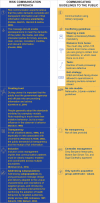When Politics Meets Pandemic: How Prime Minister Netanyahu and a Small Team Communicated Health and Risk Information to the Israeli Public During the Early Stages of COVID-19
- PMID: 33363422
- PMCID: PMC7754254
- DOI: 10.2147/RMHP.S280952
When Politics Meets Pandemic: How Prime Minister Netanyahu and a Small Team Communicated Health and Risk Information to the Israeli Public During the Early Stages of COVID-19
Abstract
Background: The coronavirus brought the world's leaders to the center of the media stage, where they not only managed the COVID-19 pandemic but also communicated it to the public. The means they used to communicate the global pandemic reveal their strategies and the narratives they chose to create in their nation's social consciousness. In Israel, the crisis broke out after three election cycles, such that the government in charge of the crisis was an interim government under the leadership of Prime Minister Benjamin Netanyahu, who was operating under three criminal indictments. This study sought to examine the ways in which Prime Minister Netanyahu and two senior Israel Ministry of Health officials-Director General Moshe Bar Siman Tov and Prof. Sigal Sadetsky, Head of Public Health Services-communicated information about the health crisis in Israel during what has been termed the first wave and the beginning of the second wave.
Methods and sample: The research adopted qualitative methods (discourse, content and thematic analysis) to analyze the communication strategies and compare them to health and risk communication. Triangulated data collection from different data sources was used to increase the credibility and validity of the results. The research sample comprised the following sources from March 3 through June 21, 2020: transcripts of 19 press conferences and 12 press interviews, 95 emergency regulations signed by Prime Minister Netanyahu, and 52 articles in major Israeli newspapers.
Results: Netanyahu and the Health Ministry Director General used an apocalyptic narrative to communicate COVID-19 to the public. The main strategies used in constructing this narrative were intimidation, lack of information transparency, giving the public conflicting instructions contrary to the health and risk communicating approach, and using a health crisis to promote political intentions and actions.
Conclusion: Communicating health crises to the public, particularly ongoing crises like COVID-19, requires that leaders implement the health and risk communication approach and create a cooperative narrative that does not rely on a strategy of intimidation, but rather on empathy and on fact-based and transparent information.
Keywords: COVID-19; Israeli public; Prime Minister Netanyahu; health and risk communication; qualitative research.
© 2020 Gesser-Edelsburg and Hijazi.
Conflict of interest statement
The authors report no conflicts of interest in this work.
Figures



Similar articles
-
Analysis of Public Perception of the Israeli Government's Early Emergency Instructions Regarding COVID-19: Online Survey Study.J Med Internet Res. 2020 May 15;22(5):e19370. doi: 10.2196/19370. J Med Internet Res. 2020. PMID: 32392172 Free PMC article.
-
When COVID-19, constitutional crisis, and political deadlock meet: the Israeli case from a disproportionate policy perspective.Policy Soc. 2020 Jul 7;39(3):442-457. doi: 10.1080/14494035.2020.1783792. eCollection 2020 Sep. Policy Soc. 2020. PMID: 35039730 Free PMC article.
-
The 'team of 5 million': The joint construction of leadership discourse during the Covid-19 pandemic in New Zealand.Discourse Context Media. 2021 Oct;43:100523. doi: 10.1016/j.dcm.2021.100523. Epub 2021 Jun 7. Discourse Context Media. 2021. PMID: 36569510 Free PMC article.
-
The political economy of healthy system reform in Israel.Health Econ. 1995 Mar-Apr;4(2):127-41. doi: 10.1002/hec.4730040205. Health Econ. 1995. PMID: 7613597 Review.
-
Risk communication on vaccines during the COVID19 pandemic: is there room for small size or private initiatives? An Israeli experience.Ther Adv Drug Saf. 2022 Aug 5;13:20420986221112189. doi: 10.1177/20420986221112189. eCollection 2022. Ther Adv Drug Saf. 2022. PMID: 35958047 Free PMC article. Review.
Cited by
-
It Takes Two to Tango: How the COVID-19 Vaccination Campaign in Israel Was Framed by the Health Ministry vs. the Television News.Front Public Health. 2022 Apr 12;10:887579. doi: 10.3389/fpubh.2022.887579. eCollection 2022. Front Public Health. 2022. PMID: 35493372 Free PMC article.
-
Trust in COVID-19 policy among public health professionals in Israel during the first wave of the pandemic: a cross-sectional study.Isr J Health Policy Res. 2022 Apr 11;11(1):20. doi: 10.1186/s13584-022-00529-6. Isr J Health Policy Res. 2022. PMID: 35410309 Free PMC article.
-
The Israeli health system's rapid responses during the COVID-19 pandemic.Isr J Health Policy Res. 2024 Mar 4;13(1):11. doi: 10.1186/s13584-024-00596-x. Isr J Health Policy Res. 2024. PMID: 38438926 Free PMC article.
-
Physicians' Perspective on Vaccine-Hesitancy at the Beginning of Israel's COVID-19 Vaccination Campaign and Public's Perceptions of Physicians' Knowledge When Recommending the Vaccine to Their Patients: A Cross-Sectional Study.Front Public Health. 2022 Mar 10;10:855468. doi: 10.3389/fpubh.2022.855468. eCollection 2022. Front Public Health. 2022. PMID: 35356022 Free PMC article.
-
How to Make Health and Risk Communication on Social Media More "Social" During COVID-19.Risk Manag Healthc Policy. 2021 Aug 25;14:3523-3540. doi: 10.2147/RMHP.S317517. eCollection 2021. Risk Manag Healthc Policy. 2021. PMID: 34471393 Free PMC article.
References
-
- WHO Director-General. Statement on the Second Meeting of the International Health Regulations (2005) Emergency Committee Regarding the Outbreak of Novel Coronavirus (2019-Ncov). Geneva, Switzerland: WHO; 2020.
-
- Bennett P, Calman K, Curtis S, Fischbacher-Smith D. Risk Communication and Public Health. Second ed. Oxford: Oxford University Press; 2010.
-
- Gesser-Edelsburg A, Shir-Raz Y. Risk Communication and Infectious Diseases in an Age of Digital Media. London and New York: Routledge; 2016.
LinkOut - more resources
Full Text Sources

